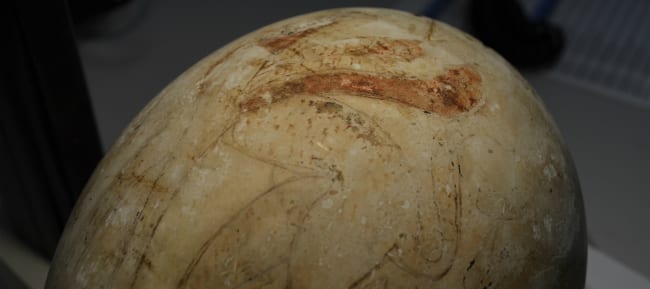By Tamar Hodos
Factors addressed in the Trade, labour, capital challenge were of tremendous importance in the ancient world, just as they are today.
The Globalising Luxuries project is a collaboration between Bristol University and the British Museum to explore the production and distribution of luxury objects around the wider ancient Mediterranean world. It seeks to integrate the skilled craftsmen and traders into the social narrative of luxury object manufacture and dissemination.

Decorated ostrich eggs were luxury items in antiquity. They were used as jugs and cups, and were engraved, painted, and sometimes embellished with ivory, preciously metals and faience fittings. They have been found primarily in elite funerary contexts from Mesopotamia and the Levant to the wider Mediterranean throughout the region’s Bronze and Iron Ages (3rd-2nd millennium BCE and c.1st millennium BCE respectively). These represent different cultures that were often in conflict with one another.
Migrant art?
Most research on these objects has focused on their iconography to determine who decorated them. But this equates decorative style with cultural identity, which is particularly problematic when we know that artisans were known to migrate, or be moved, and often in the employ of royal or elite patrons.
To address this, we are using a combination of isotopic indicators, high resolution microscopy and digital and scanning electron microscopy. With these techniques together, we are determining where an egg was laid, whether it laid by a wild or captive bird, and distinguishing working techniques, including pigments.
Routes to luxury
Through these methods, we are understanding better the mechanisms and routes of luxury production and trade in the ancient world. In turn, this will help us understand the full extent of the role luxuries play in today’s globalised world. This includes highlighting the roles played by the procurers of raw materials, the fashioning craftsmen, and the traders and merchants who distribute them.
MMB offers an exciting space to learn from others looking at the implications of migration and mobility of all kinds. Looking at organic luxuries brings us into contemporary issues to do with the acquisition and trade in ivory, for example.
I am keen to do modelling with my data, so if there is anyone working on migration and trade in the contemporary world who would like to collaborate on a little something along these lines with me, please let me know!
Dr Tamar Hodos, is a Reader in Mediterranean Archaeology, Department of Anthropology and Archaeology. She is currently working on Globalising Luxuries and this project is linked to the MMB challenge on Trade, labour, capital

